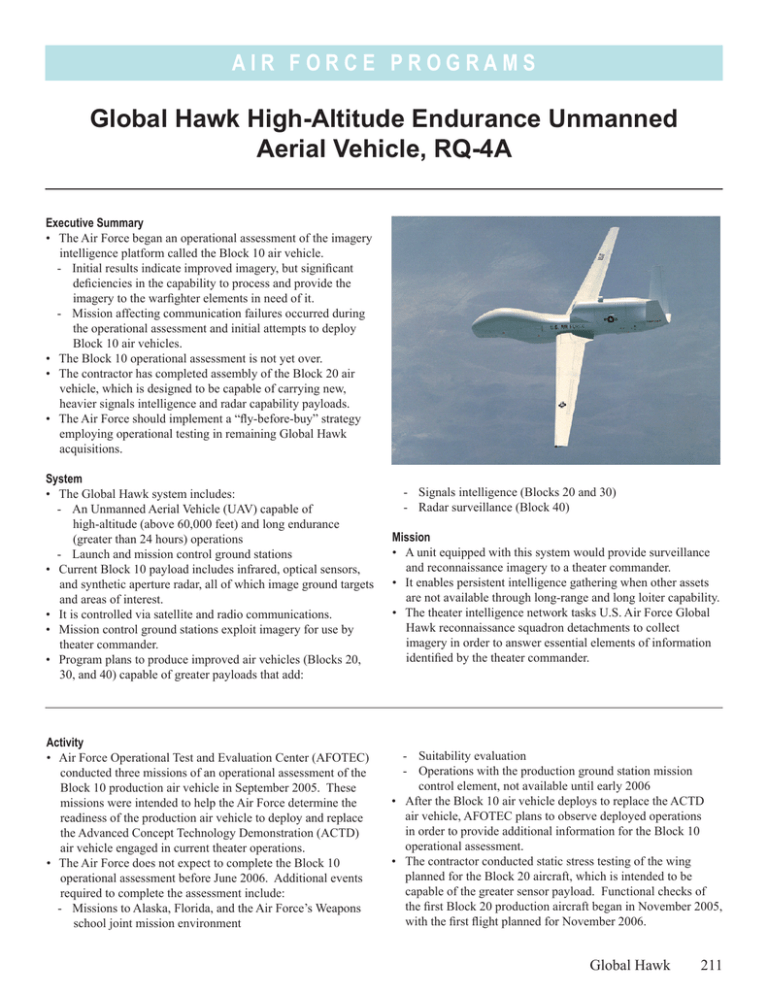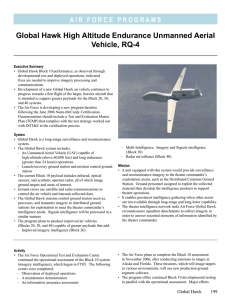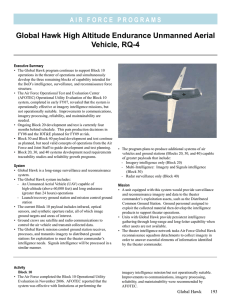Global Hawk High-Altitude Endurance Unmanned Aerial Vehicle, RQ-4A
advertisement

AIR FORCE PROGRAMS Global Hawk High-Altitude Endurance Unmanned Aerial Vehicle, RQ-4A Executive Summary • The Air Force began an operational assessment of the imagery intelligence platform called the Block 10 air vehicle. - Initial results indicate improved imagery, but significant deficiencies in the capability to process and provide the imagery to the warfighter elements in need of it. - Mission affecting communication failures occurred during the operational assessment and initial attempts to deploy Block 10 air vehicles. • The Block 10 operational assessment is not yet over. • The contractor has completed assembly of the Block 20 air vehicle, which is designed to be capable of carrying new, heavier signals intelligence and radar capability payloads. • The Air Force should implement a “fly-before-buy” strategy employing operational testing in remaining Global Hawk acquisitions. System • The Global Hawk system includes: - An Unmanned Aerial Vehicle (UAV) capable of high-altitude (above 60,000 feet) and long endurance (greater than 24 hours) operations - Launch and mission control ground stations • Current Block 10 payload includes infrared, optical sensors, and synthetic aperture radar, all of which image ground targets and areas of interest. • It is controlled via satellite and radio communications. • Mission control ground stations exploit imagery for use by theater commander. • Program plans to produce improved air vehicles (Blocks 20, 30, and 40) capable of greater payloads that add: Activity • Air Force Operational Test and Evaluation Center (AFOTEC) conducted three missions of an operational assessment of the Block 10 production air vehicle in September 2005. These missions were intended to help the Air Force determine the readiness of the production air vehicle to deploy and replace the Advanced Concept Technology Demonstration (ACTD) air vehicle engaged in current theater operations. • The Air Force does not expect to complete the Block 10 operational assessment before June 2006. Additional events required to complete the assessment include: - Missions to Alaska, Florida, and the Air Force’s Weapons school joint mission environment - Signals intelligence (Blocks 20 and 30) - Radar surveillance (Block 40) Mission • A unit equipped with this system would provide surveillance and reconnaissance imagery to a theater commander. • It enables persistent intelligence gathering when other assets are not available through long-range and long loiter capability. • The theater intelligence network tasks U.S. Air Force Global Hawk reconnaissance squadron detachments to collect imagery in order to answer essential elements of information identified by the theater commander. - Suitability evaluation - Operations with the production ground station mission control element, not available until early 2006 • After the Block 10 air vehicle deploys to replace the ACTD air vehicle, AFOTEC plans to observe deployed operations in order to provide additional information for the Block 10 operational assessment. • The contractor conducted static stress testing of the wing planned for the Block 20 aircraft, which is intended to be capable of the greater sensor payload. Functional checks of the first Block 20 production aircraft began in November 2005, with the first flight planned for November 2006. Global Hawk 211 AIR FORCE PROGRAMS Assessment • The Block 10 air vehicle demonstrated performance similar to that of the ACTD air vehicle already in service. It has improved spot image quality. However, image processing, timeliness, communications, mission planning, and interoperability with the ground segments used to provide the imagery in usable form to the warfighter require significant improvement. Communications failures delayed the initial deployment attempts in October 2005 and continue to occur in Block 10 developmental test missions. • In-flight shutdowns of the air vehicle engines occurred during Block 10 testing and ACTD operational missions. The program discovered deficiencies in late production versions of the engine that resulted in reduced surge margin at high-altitude (i.e., greater than 60,000 feet). The same engine is planned for use in the heavier, larger Blocks 20, 30, and 40 aircraft. • The Air Force plans to conduct an IOT&E with a Block 20 (imagery intelligence only) system capable of meeting Increment 1 performance criteria in early 2009—24 months later than the current program baseline established in 2002, 212 Global Hawk and five years later than the original 2001 program baseline. The November 2005 DAB directed the development of revised acquisition and test strategies to include determination of an appropriate number of low-rate initial production quantities. Recommendations 1. The remaining test events in the Block 10 operational assessment test plan should be completed. This includes the evaluation in the joint mission environment and evaluation of the Block 10 mission control element ground segment. These events provide the opportunity to evaluate the Global Hawk in other than desert environments. 2. Conduct a review and correct deficiencies in the intelligence, surveillance, and reconnaissance network in which Global Hawk operates—imagery processing and dissemination need attention and improvement, as highlighted in the Block 10 operational assessment missions performed in August 2005. 3. Low-rate initial production quantities should not be increased until after an adequate IOT&E of the Block 20 air vehicle and ground segments.






